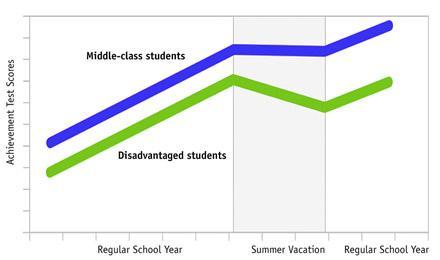
To a certain extent, all children experience learning loss during the summer months when the school year ends. The temporary cessation of formal classes provided by the school has the effect of reducing the amount of quality organized learning opportunities resulting in the loss of some of the educational growth that previously occurred during the academic year. Research spanning 100 years shows that students typically score lower on standardized tests at the end of summer vacation than they do on the same tests at the beginning of the summer (White, 1906; Heyns, 1978; Entwisle & Alexander 1992; Cooper, 1996; Downey et al, 2004).
The achievement gap refers to the persistent disparity of test scores and assessments between groups of students, especially groups defined by socioeconomic status, race/ethnicity, and gender. Summer plays a huge role in the problem — and the solution. Johns Hopkins University researchers estimate that as much as two-thirds of the achievement gap can be traced to summer learning loss in school. And because that loss is cumulative, the achievement gap may never close.  During the summer months, under-represented children tread water at best or even fall behind, while children from more advantaged families build their skills steadily.
During the summer months, under-represented children tread water at best or even fall behind, while children from more advantaged families build their skills steadily.
Many Americans have a wonderful image of summer as a carefree, happy time when “kids can be kids,” and take for granted the prospect of enriching experiences such as summer camps, time with family, and trips to museums, parks, and libraries. Unfortunately, many under-represented youths face anything but idyllic summer months, often struggling to access educational opportunities, as well as basic needs such as healthy meals and adequate adult supervision.
Parents with the means invest more time and money than ever before in their children while lower-income families, which are now more likely to be headed by a single parent, are increasingly stretched for time and resources (1).
Children whose families are not struggling financially have more opportunities to participate in camps and other educational programs during the summer that will help their minds stay sharp and retain more of what they learned during the school year (2).
Longitudinal studies indicate that the effects of summer learning programs endure for at least two years after participation (3).

We believe that the children of families who are financially disadvantaged should have the same opportunity. A Thousand Summers Camperships help under-represented children learn independence and safe risk-taking, build essential mentor relationships, and reap the benefits of connecting with nature. Research shows that summer learning programs such as summer camps remove barriers to success, with participating students showing improved school attendance, and more positive attitudes toward learning.
